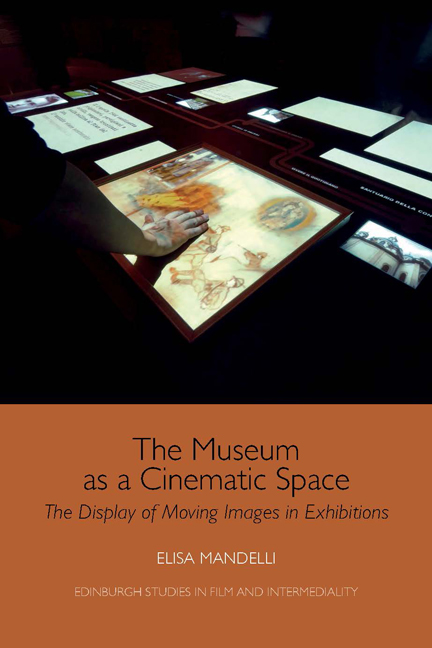Book contents
- Frontmatter
- Contents
- List of Figures
- Acknowledgements
- Preface
- Introduction
- Part I Between History and Modernity: Films in Exhibitions in the Twentieth Century
- 1 Cinema, Museums, Memory and Education
- 2 ‘A dimly-lighted corner’: Moving Images in Museums in the First Decades of the Twentieth Century
- 3 Moving Images in Museums, World's Fairs and Avant-garde Exhibition Design
- 4 The Multi-media Museum: The 1960s–70s
- Part II The Museum as a Cinematic Space: Museums and Moving Images in the Twenty-first Century
- Conclusions
- Bibliography
- Index
1 - Cinema, Museums, Memory and Education
from Part I - Between History and Modernity: Films in Exhibitions in the Twentieth Century
Published online by Cambridge University Press: 24 October 2019
- Frontmatter
- Contents
- List of Figures
- Acknowledgements
- Preface
- Introduction
- Part I Between History and Modernity: Films in Exhibitions in the Twentieth Century
- 1 Cinema, Museums, Memory and Education
- 2 ‘A dimly-lighted corner’: Moving Images in Museums in the First Decades of the Twentieth Century
- 3 Moving Images in Museums, World's Fairs and Avant-garde Exhibition Design
- 4 The Multi-media Museum: The 1960s–70s
- Part II The Museum as a Cinematic Space: Museums and Moving Images in the Twenty-first Century
- Conclusions
- Bibliography
- Index
Summary
‘THE OCULAR EVIDENCE THAT IS TRUTHFUL AND INFALLIBLE PAR EXCELLENCE’: CINEMA, MUSEUMS AND THE PRESERVATION OF MEMORY
In The Culture of Cities, published in 1938, Lewis Mumford proclaims the death of the monument. According to the well-known critic and historian of architecture, monuments not only fail to keep memory alive, but also prevent the development of new life in the place where they are erected. To Mumford, monuments belong to the past: they are ‘a contradiction in terms’ for modern society, which is oriented towards a constant process of renewal. To be truly modern, cities should be dynamic entities, constantly adapting to new needs and lifestyles. To this aim, the memorial function must be delegated to institutions specifically created for this purpose, namely museums: ‘by confining the function of preservation to the museum, we thus release space to the rest of the city for the fresh uses of the living’. Museums are functional to the full development of modern society precisely because they represent a well-delimited place where ‘memorials of culture’ can be preserved without overwhelming people. However, they should not strive to preserve everything, but carefully select the items, and to ensure the regular rotation of the exhibits.
In Mumford's view, along with museums, mechanical media contribute to storing the memory of the past and thereby create space for the continuous renewal of life: ‘what cannot be kept in existence in material form, we may now measure, photograph in still and moving pictures, record in sounds, and summarise in books and papers’. This process of selection should take place ‘while the life is still present’, in order to obtain ‘not merely a fragment of the original shell, but a working knowledge’ of the object to be preserved. In Technics and Civilization, published a few years before The Culture of Cities, Mumford had already claimed that mechanical media share the mission of museums, since they give
modern civilization a direct sense of the past and a more accurate perception of its memorials than any other civilization had, in all probability, had. Not alone did they make the past more immediate: they made the present more historic by narrowing the lapse of time between the actual events themselves and their concrete record. For the first time one might come face to face with the speaking likenesses of dead people and recall in their immediacy forgotten scenes and actions.
- Type
- Chapter
- Information
- The Museum as a Cinematic SpaceThe Display of Moving Images in Exhibitions, pp. 17 - 26Publisher: Edinburgh University PressPrint publication year: 2019



